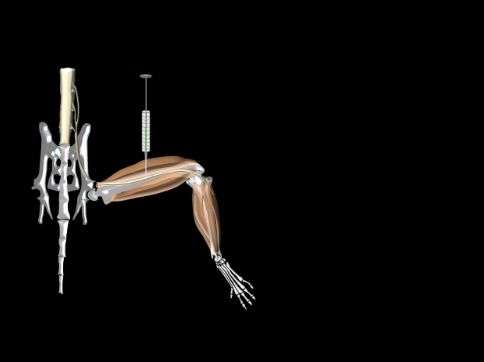April 4, 2014 report
Researchers use optogenetics to repair damaged nerve in a mouse

(Medical Xpress)—A combined team of neuroscientists and optogenics researchers in the U.K. has developed a technique for using light to restore function to muscles made useless by damaged nerves. In their paper published in the journal Science, the team describes their technique and how it might prove useful in humans sometime in the future. Shrivats Iyer and Scott Delp provide more insight into the work done by the researchers in a Perspective piece in the same journal issue.
Damaged nerves, whether due to trauma or disease are still a major health problem, leading to a wide variety of disabilities in people around the world. At its root, the problem quite often boils down to an inability to cause nerve cells to regenerate. In this new effort, the researchers set out to discern if optogentics might help.
Optogentics is where cells are modified to produce proteins that respond to light. With nerve cells, that would mean the presence of light would cause them to fire. Up till now, most research involving optogenetics has revolved around brain studies. In this new effort, the researchers used what has been learned to date to cause the restoration of muscle function in a mouse leg.
The researchers started by modifying a group of embryonic stems cell to cause them to produce a protein responsive to light. Next, they programed the cells to grow into nerve cells, which were implanted onto the ligated sciatic nerve of a mouse. After allowing time for the implanted cells to integrate with the existing cells, the researches cut the mouse open again and shone a light on the implant. Doing, so, they discovered, caused activation of the leg muscles.
The results of the research suggests that optgenetics might be useful as a therapeutic technique, not as a means of instantly restoring function—it would be used in a way similar to electrical stimulation therapy techniques that encourage the regeneration of lost nerve cells.
Also, while the research does show that nerve pathways can be reestablished using optogenetics, as Iyer and Delp point out, there is still a lot to be learned before such science might be used for treatment in humans. One serious question is whether the technique could be used on a patient that is not under anesthesia, or would it cause too much pain in someone who is awake. Another is how to control the flow of electricity from the cells to the muscle—in the study, repeated activations led to deformed muscle structure.
More information: Optical Control of Muscle Function by Transplantation of Stem Cell–Derived Motor Neurons in Mice, Science 4 April 2014: Vol. 344 no. 6179 pp. 94-97 DOI: 10.1126/science.1248523
Abstract
Damage to the central nervous system caused by traumatic injury or neurological disorders can lead to permanent loss of voluntary motor function and muscle paralysis. Here, we describe an approach that circumvents central motor circuit pathology to restore specific skeletal muscle function. We generated murine embryonic stem cell–derived motor neurons that express the light-sensitive ion channel channelrhodopsin-2, which we then engrafted into partially denervated branches of the sciatic nerve of adult mice. These engrafted motor neurons not only reinnervated lower hind-limb muscles but also enabled their function to be restored in a controllable manner using optogenetic stimulation. This synthesis of regenerative medicine and optogenetics may be a successful strategy to restore muscle function after traumatic injury or disease.
© 2014 Medical Xpress


















